In 1962, the Seattle World's Fair was held in the northwestern capital city. The legacy of that event goes well beyond the iconic Seattle Space Needle (right) and is explored in a panoply of summer and fall educational and entertainment festivities celebrating the 50th Anniversary. One of the "Next50" happenings is an interactive exhibit to highlight the role of Washington State's life science research innovations in addressing global health challenges. If space exploration was the governing dream of the near future in the 1960's, our generation's overriding fascination may be with possibilties inherent in life science research discoveries and their applications for transforming the health of millions of people worldwide in order to lead fuller, longer lives.
Recent Posts
Tags: UW, University of Washington, Northwest, Lab-on-a-chip Technology, 2012, science event, Event, Front Line event, science current event, Seattle, bioscience event, Science research hub, scientist solutions, Exhibit space
How is it that a prominent Rockefeller University professor and director of the Laboratory of Neurogenetics and Behavior is sought out by a fashion magazine one month, the New York Magazine the next, and a CBS interview just last week? Dr. Leslie Vosshall studies the mechanism of scent recognition in humans on the one hand, and attraction to humans by mosquitos on the other. We still know so little about smell, and even less about why an insect like the mosquito hones in on one of us more often than another, but the Vosshall Lab is adding insight to the genetic basis of olfactory recognition. Given that mosquitos are a global vector for disease, including right here in the U.S., Vosshall's research aims to find out what it is about a particular one of us that excites the little bug to such raptures. If we know that, perhaps we can intervene productively to keep them at bay. As for the fashion magazine (Elle Canada), they wanted an expert on scent to comment on designers' and retailers' new fad for marketing their products with a scent component.
Tags: Rockefeller University, Northeast, women in science, New York, 2012, genetic engineering, Neuroscience, BioResearch Product Faire Event, NY, New York City
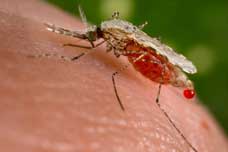 It's summer in the Northern Hemisphere, and in most places that means mosquitos are out for our blood, which wouldn't be much to give up if it weren't for the itchy -- and in many parts of the world, deadly -- package that the tiny insect leaves behind. Plasmodium falciparum is the human malaria pathogen that kills over a million people annually around the world (largely infants, young children and pregnant women, most of them in Africa). One approach to combatting the spread of the disease is to genetically engineer a mosquito that cannot transmit the parasite and yet is able to reproduce with mosquitos that do, in order to infiltrate and alter the population overall to become one that is benign (except for the itching).
It's summer in the Northern Hemisphere, and in most places that means mosquitos are out for our blood, which wouldn't be much to give up if it weren't for the itchy -- and in many parts of the world, deadly -- package that the tiny insect leaves behind. Plasmodium falciparum is the human malaria pathogen that kills over a million people annually around the world (largely infants, young children and pregnant women, most of them in Africa). One approach to combatting the spread of the disease is to genetically engineer a mosquito that cannot transmit the parasite and yet is able to reproduce with mosquitos that do, in order to infiltrate and alter the population overall to become one that is benign (except for the itching).
Tags: CA, University of California Irvine, Southwest, California, 2012, genetic engineering, BioResearch Product Faire Event, Irvine, UCI
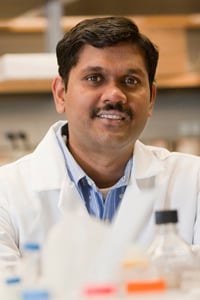 The first construction of an image by Nuclear Magnetic Resonance (NMRI) by Dr. Paul Lauterbur took place at the University at Stony Brook thirty years ago, and the Stony Brook Chemistry professor went on to win the 2003 Nobel Prize for his work. So it's fitting that another breakthrough in MRI technology is also taking place at the Long Island research university, this time by biomedical engineer Balaji Sitharaman, right, and his team, who have developed a potentially safer and more cost effective MRI contrast agent for improved disease diagnosis and detection. The agent is graphene-based rather than gadolinium-based, and the success of the advanced agent is documented in a recent PLoS ONE article.
The first construction of an image by Nuclear Magnetic Resonance (NMRI) by Dr. Paul Lauterbur took place at the University at Stony Brook thirty years ago, and the Stony Brook Chemistry professor went on to win the 2003 Nobel Prize for his work. So it's fitting that another breakthrough in MRI technology is also taking place at the Long Island research university, this time by biomedical engineer Balaji Sitharaman, right, and his team, who have developed a potentially safer and more cost effective MRI contrast agent for improved disease diagnosis and detection. The agent is graphene-based rather than gadolinium-based, and the success of the advanced agent is documented in a recent PLoS ONE article.
Tags: biomedical sciences, biomedical research, Northeast, New York, Stony Brook University, venture development in life sciences, BioResearch Product Faire Event, Biomedical Research Funding, scientist solutions, life science products, science solution
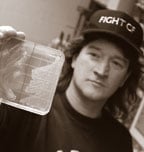 University of Cincinnati College of Medicine molecular geneticist Daniel Hassett (right) has made a name for himself as a determined researcher in the fight against cystic fibrosis (CF). He is also on the front line of bioscience research into creating "superbugs" that eat waste and generate energy, improving dramatically on the efficiency of traditional waste water treatment systems. In a radio interview on WVXU Cincinnati's Focus on Technology, commentator Ann Thompson describes the problem: the largest user of energy is wastewater treatment; the second largest user of water is energy production. If you can find a way to both clean water and generate electricity, you're in business.
University of Cincinnati College of Medicine molecular geneticist Daniel Hassett (right) has made a name for himself as a determined researcher in the fight against cystic fibrosis (CF). He is also on the front line of bioscience research into creating "superbugs" that eat waste and generate energy, improving dramatically on the efficiency of traditional waste water treatment systems. In a radio interview on WVXU Cincinnati's Focus on Technology, commentator Ann Thompson describes the problem: the largest user of energy is wastewater treatment; the second largest user of water is energy production. If you can find a way to both clean water and generate electricity, you're in business.
Tags: Bioscience research, Midwest, Ohio, biomedical research, University of Cincinnati, genetic engineering, molecular ecology research, BioResearch Product Faire Event, Cincinnati, BRPF, research scientist
Tags: vendor, vendor shows, Biotechnology Calendar, Event, Biotechnology Vendor, Sales, Laboratory Equipment Supplier, scientist vendor shows, science sales leads, Lab supplier Showcase, Lab Supplier event, science brands
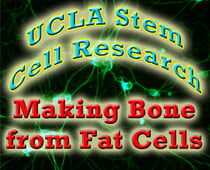 Bone marrow was the first stem cell source to be widely used in clinical transplant surgery to replace damaged bone as a result of injury or chemotherapy. Unfortunately, bone marrow grafts are painful, and the appropriate donor is not always available when the need is there. Now research at the University of California Los Angeles' Broad Center of Regenerative Medicine has demonstrated successfully that stem cells from the patient's own fat (i.e. adipose tissue) can be made usable for bone damage treatment. Bone marrow is, after all, the soft, fatty tissue inside your bones that contains immature cells (aka stem cells) that give rise to all of your blood cells. So looking to fatty tissue from another part of the body to produce mesenchymal cells has made sense all along, though it has taken the efforts of several UCLA teams to show how it can be done in an animal model.
Bone marrow was the first stem cell source to be widely used in clinical transplant surgery to replace damaged bone as a result of injury or chemotherapy. Unfortunately, bone marrow grafts are painful, and the appropriate donor is not always available when the need is there. Now research at the University of California Los Angeles' Broad Center of Regenerative Medicine has demonstrated successfully that stem cells from the patient's own fat (i.e. adipose tissue) can be made usable for bone damage treatment. Bone marrow is, after all, the soft, fatty tissue inside your bones that contains immature cells (aka stem cells) that give rise to all of your blood cells. So looking to fatty tissue from another part of the body to produce mesenchymal cells has made sense all along, though it has taken the efforts of several UCLA teams to show how it can be done in an animal model.
Tags: University of California Los Angeles, Stem cell research, cancer research, Southwest, California, Los Angeles, UCLA, Research, Stem Cell, Biotechnology Vendor Showcase, BVS, science solution
While magnetic resonance imaging (MRI) scanners are most often associated with clinical diagnostics activities, their ability to visualize internal structures of the body in detail, especially soft tissues, makes MRI scanning machines extremely valuable for laboratory research scientists as well. So it's no small matter that an NIH equipment grant has made it possible for Cornell University in Ithaca to get one of its own, just last week, and establish the Cornell MRI Facility in Martha Van Rensselaer Hall. It's not just any scanner either, but a 3 Tesla GE Discovery 750, which provides noninvasive imaging with high signal-to-noise ratio and spatial resolution for structural and functional research involving small animals, humans, plants and biomedical materials. MRI technology does not involve radiation.
Tags: Northeast, Cornell University, New research facilities, New York, NIH, Research equipment, Laboratory Imaging Equipment
 The University of Utah has explored and expoited a number of successful strategies to commercialize its intellectual capital in recent years. Their tech commercialization office is tireless in promoting its proprietary scientific solutions (see last month's blog: Science "Speed Teching" Drives Rapid Commercialization in Utah). But now we're starting to hear about another seriously innovative and fast-moving "laboratory" for cultivating new Salt Lake businesses, and it's a fairly new entity from the U of U's David Eccles School of Business called The Foundry. Instead of creating companies or corporate leaders, the Foundry is a hands-on training program designed to produce entrepreneurs who can identify a successful startup product/business and put together a qualified team to launch and run it.
The University of Utah has explored and expoited a number of successful strategies to commercialize its intellectual capital in recent years. Their tech commercialization office is tireless in promoting its proprietary scientific solutions (see last month's blog: Science "Speed Teching" Drives Rapid Commercialization in Utah). But now we're starting to hear about another seriously innovative and fast-moving "laboratory" for cultivating new Salt Lake businesses, and it's a fairly new entity from the U of U's David Eccles School of Business called The Foundry. Instead of creating companies or corporate leaders, the Foundry is a hands-on training program designed to produce entrepreneurs who can identify a successful startup product/business and put together a qualified team to launch and run it.
Tags: Utah, university of utah, Southwest, scientists solutions, laboratory, Salt Lake City, cultures
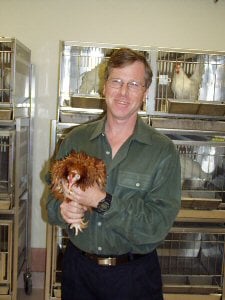 The University of Southern California has a thriving regenerative medicine research headquarters at the Broad Center within the Keck School of Medicine. Established in 2006, the Center's $80M state-of-the-art building opened in 2010 to house eleven research teams and four core laboratories. In addition to seeking out therapeutics, though, a team of USC stem cell scientists is marrying their study of stem cell functioning to a more thorough understanding of regenerative biology as it happens naturally in many species of animal. Drs. Cheng-Ming Chuong, Randall B. Widelitz (right), Ping Wu, and Ting-Xin Jiang of the Department of Pathology discuss their lab research, which looks at stem cells in hair and feathers in particular, in a recent article published in the journal Physiology.
The University of Southern California has a thriving regenerative medicine research headquarters at the Broad Center within the Keck School of Medicine. Established in 2006, the Center's $80M state-of-the-art building opened in 2010 to house eleven research teams and four core laboratories. In addition to seeking out therapeutics, though, a team of USC stem cell scientists is marrying their study of stem cell functioning to a more thorough understanding of regenerative biology as it happens naturally in many species of animal. Drs. Cheng-Ming Chuong, Randall B. Widelitz (right), Ping Wu, and Ting-Xin Jiang of the Department of Pathology discuss their lab research, which looks at stem cells in hair and feathers in particular, in a recent article published in the journal Physiology.
Tags: University of Southern California, Stem cell research, USC Science, Southwest, California, Los Angeles, animal science, biology research, Front Line event

